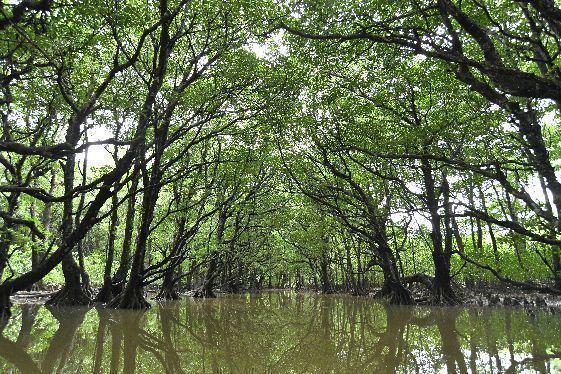Okinawa to implement policy to limit the number of people who can enter Iriomote Island, which may become a World Natural Heritage Site

A lush mangrove on Iriomote. (December, 2019, photograph taken by Yasuhide Matayoshi)
January 14, 2020 Ryukyu Shimpo
Ryota Shimabukuro
Okinawa Prefecture, which is trying to get four of their islands, Amami Oshima, Tokunoshima, the northern part of Okinawa’s main island, and Iriomote, will implement a policy that limits the number of tourists who can enter the town of Takemi on Iriomote, as part of a “master plan” to formulate sustainable tourism this year.
The limit will not be a regulation but rather a target number, and the plan is to regularly monitor entry into the island throughout the year.
Since it is expected that the number of tourists will increase with the designation as a World Natural Heritage Site, the goal is to avoid the large burden on the natural environment that would come with it.
On January 30, a regional meeting will be held for organizations concerned with Iriomote, where they will set the limit of visitors.
The International Union for Conservation of Nature and Natural Resources (IUCN) is planning on making a decision whether or not the islands become a World Natural Heritage Site this summer.
Before this happens, Okinawa hopes to formulate the master plan, translate it into English, and send it to the IUCN, in order to show them how they plan to protect the environment after the islands are registered.
Organizations such as the Nature Conservation Society of Japan have sent a written request to the IUCN asking for a recommendation for the visitor limit.
Iriomote faces problems such as the Iriomote cat, a protected species, being hit by cars, and there are some who have voiced negativity towards the expected increase in tourism that would be brought about by the island’s inclusion in the list.
This led the prefecture to settle on a visitor limit, and they have been working on building a broad consensus with the various local organizations involved with the island, as well as their cooperation toward registering the island.
In the proposed master plan, which includes the Yanbaru region, there is also a policy that would recommend a guide to accompany visitors when entering the forests in the center of the proposed heritage sites.
The goal is to attract more people to the areas around the forest, and while building enthusiasm, encouraging the accompaniment of guides to reduce the potential damage to the natural habitat, which is home to many rare species of plants and animals.
The regional meeting to decide on the visitor limit will also engage private companies such as the ferry companies, with the hopes of implementing an effective policy with the cooperation of these businesses.
(English translation by T&CT and Sam Grieb)
Previous Article:New species of “most beautiful” jellyfish found for first time in 114 years in Okinawa
Next Article:Okinawan children play in the snow for the first time, react with great enjoyment
[Similar Articles]
- IUCN defers site spanning Kagoshima and Okinawa nominated for Natural World Heritage status
- Biodiverse island areas in northern Okinawa nominated for UNESCO World Natural Heritage
- US base issues cast doubt on World Natural Heritage Site designation for Yambaru National Park woodlands
- World Natural Heritage Site evaluations in Okinawa
- Japan to resubmit Amami-Okinawa site nomination for World Natural Heritage List inscription
 Webcam(Kokusai Street)
Webcam(Kokusai Street)


